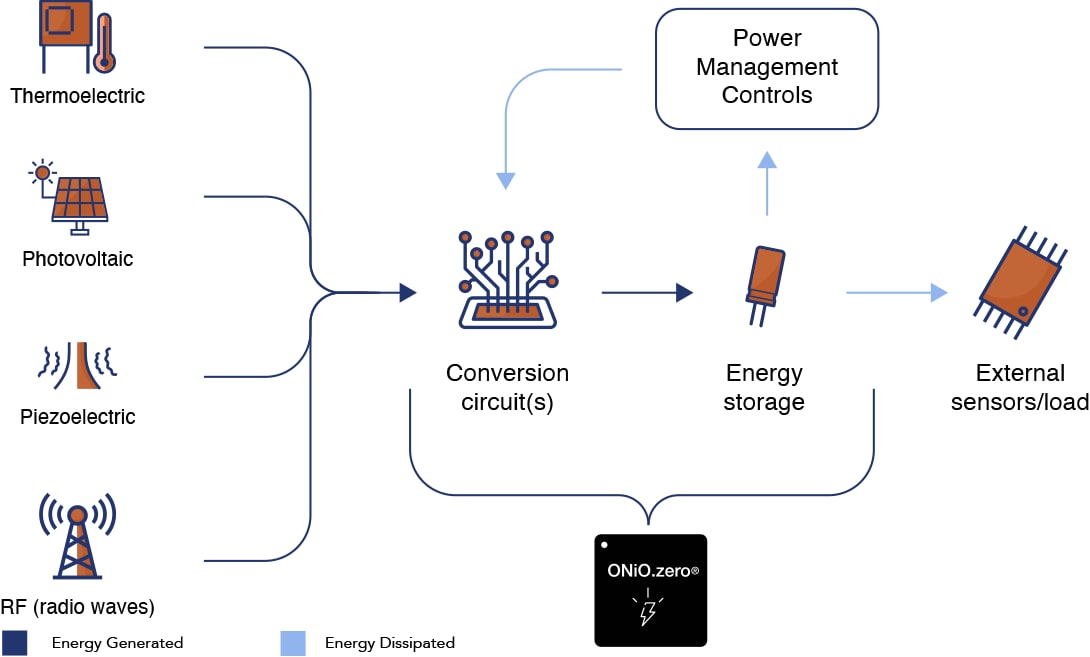5 Niche energy harvesting technologies


Energy harvesting is starting to come of age. In addition to the more popular iterations of the technology including piezoelectric energy harvesting, RF energy harvesting and thermoelectric energy harvesting, a number of new, niche energy harvesting technologies are currently being developed and studied, in labs around the world. In this article, we examine this exciting trend and list out some of the most promising niche energy harvesting technologies on the horizon.
It is becoming increasingly clear to us that the future of IoT will not be battery-powered. Perhaps unsurprisingly, it seems that the future of IoT technology will have to look beyond batteries for a tenable power solution. Energy harvesting has emerged as the go-to alternative to batteries, when it comes to IoT chips and edge devices. Energy harvesting technologies like RF energy harvesting and piezoelectric energy harvesting are already popular and find widespread use in many sectors.
However, in the last few years, there has been a dramatic upsurge in the number of projects that are working on developing new energy harvesting technologies. Many of these technologies are still in the lab-stage and might be years away, if at all, from a market-viable, commercial product. Nevertheless, this is an exciting trend and bodes well for the future of energy harvesting and self-powered sensors.
Here’s something to drive home our point - This is a 20-member list of the winners of an “open hardware” power harvesting contest conducted by hackaday. This should give you an idea of what we’re talking about. It is not just in the gleaming labs of Ivy League schools that this stuff is being studied - there’s a lot of innovation and exciting breakthroughs happening at the grassroots level.
Energy harvesting - simple, economical and safe
Universities all over the world have started pioneering their own takes on energy harvesting technologies - The basic principle behind any energy harvesting technology is quite simple - There are three basic parts - The transducer/harvester which converts ambient power from the environment into usable electrical energy, the IC, which collects and conditions the energy and the load, which uses the collected energy.

Some of these projects, you will find out in the following sections, come across as quite wacky and some just seem to defy belief with their sophistication and ingenuity.
So, why this massive spike in interest you ask?
Well, for one, It is estimated that there will be over 25 billion “connected things” by the year 2025. If that isn’t a staggering figure in its own right, it actually falls dramatically short of predictions made a few years earlier. With a rapidly rising number of IoT edge devices, continuing to use batteries poses a near-impossible challenge.
Energy harvesting is an extremely promising, cheap and efficient way to circumvent this battery bottleneck.
One thing is for certain. Energy harvesting is no passing fad. So far, it seems to be the closest we have come to a sustainable and renewable energy source, albeit one that can only meet the smallest of energy requirements.
As far as most sensors and IoT devices are concerned, power requirements are not very high. Usually, these “nodes” tend to be ultra-low power devices that use extremely small packets of current to transmit data. Self-powered sensors are able to harness small amounts of power from the ambient surroundings and therefore, power themselves autonomously, without requiring an external power source.
Energy harvesting is a super-viable and cost-effective option to power small circuits - After all, they are close to free, when it comes to maintenance and cost of ownership. The IoT revolution is starting to sweep practically every industry there is and there are going to be billions if not hundreds of billions of nodes and edge devices. When it comes to powering these tiny chips and sensors, there is practically no feasible power solution available on the market other than batteries and energy harvesting.
At the moment, batteries continue to find widespread use in wearables and other IoT devices. But, as we’ve mentioned in an earlier post, batteries come with a laundry list of shortcomings and are not, by any means, a viable option, in the medium to long term. They also have disastrous environmental and humanitarian consequences.
Given these facts, it’s no surprise that energy harvesting technologies are as hot as they are, at the moment.
So, what are some of these new technologies?
You can’t draw electricity out of thin air, can you? Apparently, you can. In an earlier post, we’d spoken about how researchers from Masschussets are using nanowires to harvest energy from ambient moisture!
There are so many of these new energy harvesting methods, that we had to filter them out somehow! Here are the ones that generate power from the most unexpected sources.
1. Rust

Believe it or not, but a team of scientists from Northwestern University, have come up with a special kind of “rust” which can be used to generate electricity!
Created using a process called “physical vapour deposition”, this special iron-based coating is used to generate electricity when it comes in contact with flowing saltwater. The technology works by alternating salinity gradients by converting the kinetic energy of the flowing water into storable electrical energy.
This kind of technology has already been built using graphene (ultra-thin layers of carbon) but scalability was a major drawback with this material. To achieve a consistently thin layer, the team converted a solid chunk of iron into vapour, which was then allowed to condense on a surface of glass, creating a small iron layer (10-30 nm). This thin sheet of iron, then, spontaneously undergoes oxidation and forms a rust layer about 2nm thick.
The principle underlying this technology is called the “electrokinetic effect” and is the same principle behind the infamous high school science experiment - the potato battery!
2. Wood

Tiani Li and his team, from the University of Maryland, have found a way to transform wood such that it can make use of a low-temperature gradient to generate a voltage.
The team extracted a compound known as “lignin” and managed to separate it from the wood. After this process, all that was left of the wood were the naturally-aligned cellulose nanofibers.
This cellulose-based membrane was infused with a Sodium Hydroxide solution in order to construct a nanofluidic conductor, which they placed between two platinum electrodes. This setup was successful in generating a thermal voltage gradient, with a ration of 24 mV/K.
Their work was presented in a recently published paper titled “Cellulose ionic conductors with high differential thermal voltage for low-grade heat harvesting”.
3. Textiles, TENGs

A team based in Nanyang Technological University in Singapore has developed a fabric which acts as a touch-activated triboelectric nanogenerator (TENG). The team published their findings in a paper published recently, in early 2019.
A triboelectric nanogenerator is a type of energy harvesting device. It converts external mechanical energy into usable electricity, using the triboelectric effect and electrostatic induction.
Previous iterations of TENG-based technology have had to contend with some serious challenges - for one, they required an unwieldy, rubbery material as a “substrate”.
The Singaporean team tested many different polymer combinations along with black phosphorus, to come up with a TENG that overcame the limitations of its predecessors.
Excitingly, they were able to demonstrate a power output of about 250 to 880 V as a result of being stimulated by a small hand-generated force of less than 5 Newtons!
Similarly, a multi-institution team, led by UCLA, has developed a TENG that uses falling snow to generate electricity! Snow carries a positive charge as it falls on the earth, and this technology makes use of this fact to harvest electricity, using a silicone-based design.
4. Thermal radiation

A UCLA/Stanford team has developed an economical, simple and effective means of capturing small amounts of energy from the night sky.
This was made possible by employing radiative sky cooling, wherein a surface emits heat into the surrounding air, as thermal radiation. Some of this heat climbs up into the atmosphere and eventually reaches outer space.
The team came up with an ingenious technology that uses a polystyrene enclosure coated with aluminized mylar to capture heat that would otherwise be lost to the atmosphere, and convert it to electricity by a thermoelectric generator (TEG).
Although the prototype could only put out a meagre 25 mW/m2, the team is optimistic about cranking up the output by a factor of 20 or so, in hotter conditions.
5. Waste heat

In a recently published article, A UT Dallas physicist, Dr.Mark Lee has demonstrated his idea of using silicon nano-blades to harvest electricity from waste heat.
As we mentioned earlier, thermoelectric energy harvesting has been looked at as a promising source of green energy. The ubiquitousness of waste heat in our society make this a keenly followed technology trend.
However, the prohibitive cost of thermoelectric materials has proved to be a big challenge, so far-
“The best materials are fairly exotic — they’re either rare or toxic — and they aren’t easily made compatible with basic semiconductor technology” says Dr.Lee.
In spite of numerous spirited efforts, we have failed in our attempt to make a functional and reliable thermoelectric generator using silicon. To overcome this constraint, Lee and his team made use of “Silicon nano-blades”, which are only 80nm thick but about 640 nm in width.
The team published their findings in Nature.
Looking ahead
In spite of Covid-19 playing spoilsport, the short to medium-term future looks very bright for energy harvesting.
More and more people around the world are waking up to the precariousness of our global ecological situation. The emergence of numerous novel energy harvesting technologies is a reflection of the sincere and ingenious efforts that are being made towards the dream of clean, green energy.
We may be far away from using these technologies in a commercially viable way, but that doesn’t mean these emerging technologies can be dismissed. They are a sign of the amount of scientific interest that energy harvesting technologies are generating; Lots of funding is being made available to those working on energy harvesting solutions. It is obvious to most that energy harvesting is unquestionably going to be the future of sensor networks and IoT wearables.













